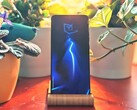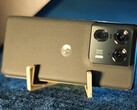Motorola Edge 50 Ultra smartphone review – The periscope zoomer with a huge storage capacity
Motorola's 2024 flagship—the Edge 50 Ultra—continues to offer a slightly cheaper price than the competition while still aiming to further catch up. In return, the manufacturer gives users a periscope zoom camera, a 144 Hz display and an extremely large amount of storage.
Not only will you have to live with yet another name change (last year's flagship was called Edge 40 Pro), but you'll also have to accept some changes compared to its predecessor—not all of which are positive.
As always, we have taken an unbiased look at the Edge 50 Ultra and will explain the pros and cons of the phone to you. Let's go.
Possible competitors compared
Rating | Date | Model | Weight | Drive | Size | Resolution | Price |
|---|---|---|---|---|---|---|---|
| 84.6 % | 07 / 2024 | Motorola Edge 50 Ultra SD 8s Gen 3, Adreno 735 | 197 g | 1 TB UFS 4.0 Flash | 6.70" | 2712x1220 | |
| 90.6 % v7 (old) | 05 / 2024 | Honor Magic6 Pro SD 8 Gen 3, Adreno 750 | 229 g | 512 GB UFS 4.0 Flash | 6.80" | 2800x1280 | |
| 89.1 % v7 (old) | 10 / 2023 | Apple iPhone 15 A16, A16 GPU 5-Core | 171 g | 128 GB NVMe | 6.10" | 2556x1179 | |
| 89.4 % v7 (old) | 05 / 2023 | Motorola Edge 40 Pro SD 8 Gen 2, Adreno 740 | 199 g | 256 GB UFS 4.0 Flash | 6.67" | 2400x1080 | |
| 89.2 % v7 (old) | 04 / 2024 | Xiaomi 14 Ultra SD 8 Gen 3, Adreno 750 | 219.8 g | 512 GB UFS 4.0 Flash | 6.73" | 3200x1440 |
Case – High-quality materials on the Edge phone
In the past years, Motorola hasn't skimped on trying out unusual ideas on its high-end phones: The packaging smells of a specially developed fragrance, unique colors are available in cooperation with Pantone and special materials are no longer taboo at Motorola.
You can already smell this scent when opening up the Edge 50 Ultra's packaging—whether it smells pleasant or a bit too much is a matter of taste according to an unrepresentative test conducted in our editorial department. The fact that the Motorola Edge 50 Ultra doesn't have quite as wide a case as other phones, on the other hand, is well received by all. The screen's glass is pulled over the side of the Edge, which allows for slim edges—but not everyone likes this design.
Some colors and materials aren't your everyday ones. Thankfully, Forest Gray (a dark gray which appears almost black with a faux leather back) should be a suitable color for anyone who likes their phone to look a little more toned down. If you want to attract attention, then you can go for Nordic Wood, which sees the phone sporting a back cover made with real wood. Alternatively, there is Peach Fuzz—an orange color that again makes use of faux leather as a material. The latter is also Pantone's color of the year.
Regardless of which version you go for, you'll always get a relatively lightweight phone if you take into account its 6.7-inch screen: The Motorola Edge 50 Ultra weighs 197 grams. Its design is super elegant, especially the slight curve from the back of the phone to the protruding camera module makes its integration look very harmonious. The device's silhouette looks very slim and it feels nice to hold thanks to the materials used for the screen and back being pulled over the phone's edges.
The Motorola smartphone's build is also nice and clean—only the transition between the frame and the back could be a little smoother. The Motorola smartphone is IP68-protected, so it can be taken on shallow dives into freshwater.
Sustainability – Room for improvement
Motorola packs its phone in a black box made of recycled material, which is printed on with soy ink. Plastic is no longer used in its packaging materials.
Motorola already states the estimated production of CO2 equivalents for several of its smartphones, but despite lengthy research, we were unable to find the document specifically for the Edge 50 Ultra.
The manufacturer also lets you buy spare parts to repair its phones, which are available via selected partner companies in many countries. Unfortunately, these are often not available for all models—they are mostly only available for older smartphones and there is often only a limited selection of parts to choose from. On iFixit, you can find repair instructions for some (but also often older) Motorola cell phones. In the United States, Motorola also offers some service manuals via third-party providers, but again, this only applies to certain models. Overall, the manufacturer's range of spare parts and support for customer repairs seems very half-hearted.
Power consumption and the frequency and duration of software updates are also included in our sustainability rating, which we will discuss in the relevant sections. Motorola is taking good steps towards sustainability, but you don't get the feeling that the manufacturer is acting very consistently at the moment, and its approach seems to be different in every country.
Connectivity – Super fast USB-C port
In most countries, you can get the Edge 50 Ultra with 12 GB RAM and 512 GB storage but in Europe, you are limited to the version with 16 GB RAM and 1 TB storage. This model has an MRSP of around US$1,000.
This is almost spectacularly cheap if you consider that the lowest price you can get one of the latest iPhones for (with this much storage) is US$1,499 for the iPhone 15 Pro, and the Samsung Galaxy S24 Ultra with 1 TB storage costs US$1,659.99. Plus, you don't get as much RAM. Only Xiaomi currently has even cheaper phones on offer with this much storage.
Motorola has already set an example here and its other features are equally impressive: The phone's USB-C port can transfer data at up to 10 Gbit/s and also complies with DisplayPort specifications, so you can easily connect external monitors.
NFC and Bluetooth 5.4 are on board, as well as ultra-wideband technology (UWB), which allows large amounts of data to be exchanged wirelessly with nearby devices. Only one nano-SIM can be used inside the Motorola Edge 50 Ultra—the second option is an eSIM. If both are combined, the phone is dual-SIM ready, with two 5G connections working simultaneously. The Edge 50 Ultra doesn't have a microSD reader for even more storage space.
Software – Stock Android with 4 years of updates
Android 14 comes preinstalled on the device. As is tradition, Motorola hasn't changed much about Google's operating system and has stored its in-house functions within the Moto app—or nowadays, inside additional apps such as Moto Secure and Moto Unplugged. One advantage this brings is that in order to access new features, you often just have to update the app rather than Motorola needing to release an entire new operating system version.
Speaking of updates: The manufacturer has promised 4 years of security patches (until May 2028) and new OS versions up to Android 17. In doing so, security patches are set to be rolled out every two months. With the phone's latest patch being from May 2024 at the time of testing, this means they are currently following this procedure as promised.
Motorola's Ready For is also supported, as is Desktop Mode and Media Center, with which you can control the phone with a mouse and keyboard or use it as a webcam. Using the Smart Connect app, you can do this wirelessly or using a USB cable that supports DisplayPort.
Communication and GNSS – WiFi 7 on board
The Motorola Edge 50 Ultra is equipped with the latest WLAN standard WiFi 7 (802.11 be). This supports 16 antennas in both transmitting and receiving directions and 2.4, 5 and 6 GHz bands can be used dynamically in a single standard. Above all, however, the phone's management of many simultaneously connected devices has been improved. Its maximum possible speed is theoretically 46 Gbit/s.
However, our test device only uses 2x2 antennas, so its speeds are significantly lower. Using our WiFi 6 router Asus ROG Rapture AXE 11000, we measured values between around 700 and 870 Mbps. This is not quite enough to really make use of a gigabit internet connection, but it is completely sufficient for fast downloads and streaming in 4K during everyday use. The speeds we measured weren't totally stable during the test.
Close to the router, we had access to the full signal and you could browse the web smoothly. 10 metres away and with 3 walls in between, 3/4 of the signal strength was still available and pages only loaded a tiny bit slower.
The Snapdragon X70 cellular modem covers all important 4G and 5G frequencies, meaning the Edge 50 Ultra can be used worldwide. During our test, we repeatedly compared the mobile reception with other high-end phones at random in various locations and can attest to very good reception performance.
| Networking | |
| Motorola Edge 50 Ultra | |
| iperf3 transmit AXE11000 6GHz | |
| iperf3 receive AXE11000 6GHz | |
| Honor Magic6 Pro | |
| iperf3 receive AXE11000 | |
| iperf3 transmit AXE11000 | |
| Apple iPhone 15 | |
| iperf3 receive AXE11000 | |
| iperf3 transmit AXE11000 | |
| Motorola Edge 40 Pro | |
| iperf3 transmit AXE11000 6GHz | |
| iperf3 receive AXE11000 6GHz | |
| Xiaomi 14 Ultra | |
| iperf3 receive AXE11000 | |
| iperf3 transmit AXE11000 | |
| iperf3 transmit AXE11000 6GHz | |
| iperf3 receive AXE11000 6GHz | |
| Average of class Smartphone | |
| iperf3 receive AXE11000 | |
| iperf3 transmit AXE11000 | |
| iperf3 transmit AXE11000 6GHz | |
| iperf3 receive AXE11000 6GHz | |
For satellite navigation purposes, the phone can access all the major networks, including GPS, Glonass, Beidou, Galileo and the Indian NavIC. Unfortunately, it doesn't support SBAS for even more precise locating. If you step outside with the Edge 50 Ultra, you are very quickly located with an accuracy of 3 meters.
In order to say how accurate the phone locates in practical use, we hopped on our bikes with it and took the Garmin Venu 2 with us to compare. Although it showed some smaller deviations from time to time, the phone generally recorded the route we took very well and even mastered difficult parts such as narrow alleyways.
As a result, we can recommend this device for more demanding navigation tasks.
Telephone features and call quality – Clear, but a little distanced
Motorola hasn't changed anything about the standard Android telephone app. If required, you can also download different apps from the Google Play Store.
If you call someone, then you can hear their voice quite clearly using the earpiece—but they sound a little distant. The user's voice is transmitted clearly and background noise is filtered out quite effectively.
If you would like to make a call using the phone's loudspeaker, then the person on the other end of the line also doesn't sound the most present, but you can understand them well. During our test, the microphone recorded our voice very precisely and transmitted it this way to the person we were speaking to.
Cameras – Great, but no 8K videos
Now things are getting exciting: Motorola has given the Edge 50 Ultra a 64-megapixel tele-camera with a periscope zoom, which enables up to 3x zoom while keeping your shots stable thanks to its optical image stabilization.
Together with the 50-megapixel main camera and the ultra-wide-angle lens (also 50-megapixel resolution), this opens up numerous possibilities for image composition. We have included a zoom range from ultra-wide-angle to 100x hybrid zoom below, taken from our photo comparison in the Alps. This will be online soon and will shed more light on the Motorola Edge 50 Ultra's camera performance compared to the Sony Xperia 1 VI.
The main camera's sensor, like that of the telephoto zoom camera, is made by Omnivision and takes very crisp photos featuring good but not exaggerated colors. However, it normally only has a resolution of 12.5 megapixels. If you want to use the full resolution, you can do so using a special mode which can be found within the camera software. There are slight imperfections in darker areas of the photo of our surroundings, but you can generally enlarge the photos without too much loss of quality. Sharpness and level of detail are high, but you can see some slight chromatic aberrations on one of the roofs.
The Motorola Edge 50 Ultra's photo quality is also superb in less good lighting conditions with high contrasts: Its sharpness is good and the candle flame isn't overexposed—but a little more detail could be recognizable in dark areas.
At first glance, the wide-angle camera also takes good pictures, but you can only really recognize a few details on closer inspection.
Unfortunately, fans of 8K videos will not be happy with the Motorola Edge 50 Ultra: Its maximum video resolution is 4K at 60fps. You can easily zoom between the ultra-wide-angle and the main camera in 0.1 increments while recording. Only if you want to use the telephoto camera do you have to decide to use it before recording, as it is not used when zooming. The photos look super sharp and the autofocus does a great job.
Finally, there is the front camera, which also has a resolution of 50 megapixels. The sensor is one made by Samsung and is often used as the main camera in inexpensive mid-range phones. Selfies taken on this camera look good and you can still recognize some details even in dark areas. However, if you enlarge the photos too much, they become a little low in detail.
Image comparison
Choose a scene and navigate within the first image. One click changes the position on touchscreens. One click on the zoomed-in image opens the original in a new window. The first image shows the scaled photograph of the test device.
Main camera plantMain camera surroundingsMain camera low lightUltra-wide-angle cameraThe main camera additionally had to prove itself in our photo studio: At full brightness, text against a red background appeared slightly blurred at the edges but otherwise, the image appeared quite sharp across the entire photo and the colors looked good.
Even at only 1 lux of residual light, the smartphone camera was still able to make a lot visible, however, display errors occurred with fine text depending on the background color.

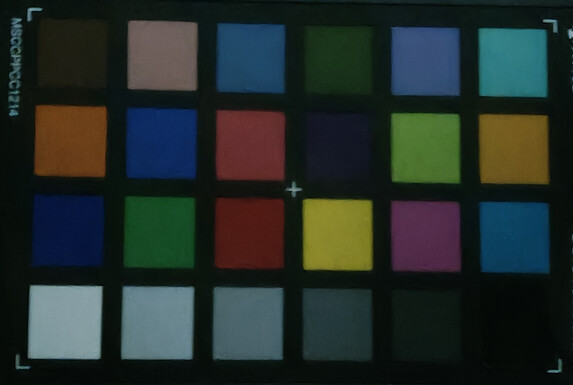
Accessories and warranty – Lots included
Unlike other smartphones, the Motorola Edge 50 Ultra comes with a large accessory package— and even with a hard plastic protective cover. Also included is a quick charger, USB cable and a SIM tool.
The warranty is 12 months as long as the smartphone was purchased within the United States.
You can additionally purchase MotoCare after buying the device, which is an accident cover lasting up to 3 years. However, you should also check out other insurance packages to make sure you get the most for your money.
Input devices & operation – 360 Hz sampling rate on the touchscreen
While the Motorola Edge 40 Pro has a 165-Hz display that caused a real stir, the Edge 50 Ultra only has a maximum refresh rate of 144 Hz. Still, hardly anyone should notice this difference: The Edge 50 Ultra is still buttery smooth and we didn't find a single app that caused stutters in its operation.
The touchscreen is scanned for inputs up to 260 times per second and is sensitive right to the edges. At the same time, accidental touch inputs (such as the palm of your hand coming into contact with the screen edges) are recognized well and don't usually lead to any problems.
The fingerprint sensor is housed behind the screen and it has been positioned well, meaning you can reach it well regardless of whether you have big or small hands. Once prints have been saved, the sensor unlocks the phone reliably—but it is a little slow for a flagship phone.
You can additionally unlock the phone via facial recognition, but it only uses the front-facing camera without the help of an additional sensor, so it isn't quite as secure. Even so, this method works reliably and the screen's brightness is enough to ensure good recognition rates in dark environments.
Display – High-res and color-accurate
Compared to its predecessor, Motorola has increased this model's resolution to 2,712 x 1,220 pixels. This makes its depiction look even smoother and at 6.7 inches, it also offers a little more surface space. Within the class comparison, its resolution is average but the manufacturer has likely found a good compromise between power consumption and a smooth picture.
The screen's brightness is very competitive, as the Edge 50 Ultra already reaches values up to 1,390 cd/m² when depicting a completely white screen. When showing small white excerpts, it achieves brightness values of up to 1,543 cd/m². This makes HDR content no problem for the phone to depict and its brightness is still more than enough to be able to use the phone in extremely bright surroundings.
Unfortunately, we noted quite strong flickering at low brightness levels, so sensitive users may have issues such as headaches during use. Furthermore, the flickering's amplitude is very high, which means it is very noticeable. Our tip: If you have already noticed issues surrounding flickering OLED screens, then we would recommend trying out the Edge 50 Ultra at a store before committing to a purchase.
| |||||||||||||||||||||||||
Brightness Distribution: 90 %
Center on Battery: 1326 cd/m²
Contrast: ∞:1 (Black: 0 cd/m²)
ΔE ColorChecker Calman: 0.51 | ∀{0.5-29.43 Ø4.78}
ΔE Greyscale Calman: 0.6 | ∀{0.09-98 Ø5}
97.5% sRGB (Calman 2D)
Gamma: 2.191
CCT: 1355 K
| Motorola Edge 50 Ultra P-OLED, 2712x1220, 6.7" | Honor Magic6 Pro OLED, 2800x1280, 6.8" | Apple iPhone 15 Super Retina XDR OLED, 2556x1179, 6.1" | Motorola Edge 40 Pro P-OLED, 2400x1080, 6.7" | Xiaomi 14 Ultra AMOLED, 3200x1440, 6.7" | |
|---|---|---|---|---|---|
| Screen | -102% | -95% | -71% | -89% | |
| Brightness middle (cd/m²) | 1326 | 1575 19% | 1046 -21% | 1056 -20% | 997 -25% |
| Brightness (cd/m²) | 1312 | 1508 15% | 1019 -22% | 1055 -20% | 1002 -24% |
| Brightness Distribution (%) | 90 | 89 -1% | 94 4% | 92 2% | 96 7% |
| Black Level * (cd/m²) | |||||
| Colorchecker dE 2000 * | 0.51 | 1.7 -233% | 1.4 -175% | 1.28 -151% | 1.6 -214% |
| Colorchecker dE 2000 max. * | 1.85 | 3.9 -111% | 2.84 -54% | 2.85 -54% | 3.3 -78% |
| Greyscale dE 2000 * | 0.6 | 2.4 -300% | 2.4 -300% | 1.7 -183% | 1.8 -200% |
| Gamma | 2.191 100% | 2.22 99% | 2.158 102% | 2.206 100% | 2.19 100% |
| CCT | 1355 480% | 6398 102% | 6410 101% | 6320 103% | 6493 100% |
* ... smaller is better
Screen Flickering / PWM (Pulse-Width Modulation)
| Screen flickering / PWM detected | 239.2 Hz Amplitude: 9 % | ||
The display backlight flickers at 239.2 Hz (worst case, e.g., utilizing PWM) . The frequency of 239.2 Hz is relatively low, so sensitive users will likely notice flickering and experience eyestrain at the stated brightness setting and below. In comparison: 53 % of all tested devices do not use PWM to dim the display. If PWM was detected, an average of 8111 (minimum: 5 - maximum: 343500) Hz was measured. | |||
Measurement series with fixed zoom level and different brightness settings
When using the mode "Natural", you likely won't get a more accurate color depiction on the Motorola Edge 50 Ultra: Its deviations from the color space's target value are mostly below 1, whereby even the slightly raised values won't be perceptible by the naked eye. This means you can evaluate colors extremely accurately on this phone.
Its response times are also super fast and should even be enough for users with high demands.
Display Response Times
| ↔ Response Time Black to White | ||
|---|---|---|
| 1.6 ms ... rise ↗ and fall ↘ combined | ↗ 0.8 ms rise | |
| ↘ 0.8 ms fall | ||
| The screen shows very fast response rates in our tests and should be very well suited for fast-paced gaming. In comparison, all tested devices range from 0.1 (minimum) to 240 (maximum) ms. » 8 % of all devices are better. This means that the measured response time is better than the average of all tested devices (20.2 ms). | ||
| ↔ Response Time 50% Grey to 80% Grey | ||
| 2 ms ... rise ↗ and fall ↘ combined | ↗ 1 ms rise | |
| ↘ 1 ms fall | ||
| The screen shows very fast response rates in our tests and should be very well suited for fast-paced gaming. In comparison, all tested devices range from 0.165 (minimum) to 636 (maximum) ms. » 8 % of all devices are better. This means that the measured response time is better than the average of all tested devices (31.6 ms). | ||
Performance – No longer in the lead
Motorola has been a little sneaky when it comes to the phone's performance: While the Motorola Edge 40 Pro from last year still used the fastest mobile processor for Android devices (the Snapdragon 8 Gen 2), this year's model features the Snapdragon 8s Gen 3. At first glance, this doesn't sound like a big difference and our test device is in fact still very fast.
However, in terms of processor performance, this year's Edge 50 Ultra can no longer completely keep up with the absolute top-of-the-range smartphones. This is due to the fact that the processor has a lower clock speed and fewer processing cores. Moreover, quite a few AI features have been axed. Even so, it is unlikely that you will notice a difference in its performance during everyday use.
| UL Procyon AI Inference for Android - Overall Score NNAPI | |
| Average of class Smartphone (3769 - 81594, n=139, last 2 years) | |
| Honor Magic6 Pro | |
| Motorola Edge 40 Pro | |
| Xiaomi 14 Ultra | |
| Average Qualcomm Snapdragon 8s Gen 3 (13576 - 15572, n=7) | |
| Motorola Edge 50 Ultra | |
The manufacturer has been less sneaky when it comes to the phone's GPU: The installed Adreno 735 can't keep up with the Adreno 740 inside the Snapdragon 8 Gen2, so the performance it offers is lower than in the Edge 40 Pro. Again, you likely won't notice a big difference—as long as you don't run super demanding apps on the smartphone.
GFXBench (DX / GLBenchmark) 2.7: T-Rex Onscreen | 1920x1080 T-Rex Offscreen
GFXBench 3.0: on screen Manhattan Onscreen OGL | 1920x1080 1080p Manhattan Offscreen
GFXBench 3.1: on screen Manhattan ES 3.1 Onscreen | 1920x1080 Manhattan ES 3.1 Offscreen
GFXBench: on screen Car Chase Onscreen | 1920x1080 Car Chase Offscreen | on screen Aztec Ruins High Tier Onscreen | 2560x1440 Aztec Ruins High Tier Offscreen | on screen Aztec Ruins Normal Tier Onscreen | 1920x1080 Aztec Ruins Normal Tier Offscreen | 3840x2160 4K Aztec Ruins High Tier Offscreen
3DMark: Steel Nomad Light Score | Steel Nomad Light Unlimited Score
| 3DMark / Wild Life Extreme Unlimited | |
| Honor Magic6 Pro | |
| Xiaomi 14 Ultra | |
| Motorola Edge 40 Pro | |
| Motorola Edge 50 Ultra | |
| Apple iPhone 15 | |
| 3DMark / Wild Life Extreme | |
| Honor Magic6 Pro | |
| Xiaomi 14 Ultra | |
| Motorola Edge 50 Ultra | |
| Motorola Edge 40 Pro | |
| Apple iPhone 15 | |
| 3DMark / Solar Bay Score | |
| Honor Magic6 Pro | |
| Xiaomi 14 Ultra | |
| Motorola Edge 50 Ultra | |
| Apple iPhone 15 | |
| 3DMark / Solar Bay Unlimited Score | |
| Honor Magic6 Pro | |
| Xiaomi 14 Ultra | |
| Motorola Edge 50 Ultra | |
| Apple iPhone 15 | |
| GFXBench (DX / GLBenchmark) 2.7 / T-Rex Onscreen | |
| Motorola Edge 40 Pro | |
| Xiaomi 14 Ultra | |
| Honor Magic6 Pro | |
| Motorola Edge 50 Ultra | |
| Apple iPhone 15 | |
| GFXBench (DX / GLBenchmark) 2.7 / T-Rex Offscreen | |
| Honor Magic6 Pro | |
| Xiaomi 14 Ultra | |
| Motorola Edge 40 Pro | |
| Motorola Edge 50 Ultra | |
| Apple iPhone 15 | |
| GFXBench 3.0 / Manhattan Onscreen OGL | |
| Motorola Edge 40 Pro | |
| Xiaomi 14 Ultra | |
| Honor Magic6 Pro | |
| Motorola Edge 50 Ultra | |
| Apple iPhone 15 | |
| GFXBench 3.0 / 1080p Manhattan Offscreen | |
| Xiaomi 14 Ultra | |
| Honor Magic6 Pro | |
| Motorola Edge 40 Pro | |
| Motorola Edge 50 Ultra | |
| Apple iPhone 15 | |
| GFXBench 3.1 / Manhattan ES 3.1 Onscreen | |
| Motorola Edge 40 Pro | |
| Honor Magic6 Pro | |
| Xiaomi 14 Ultra | |
| Motorola Edge 50 Ultra | |
| Apple iPhone 15 | |
| GFXBench 3.1 / Manhattan ES 3.1 Offscreen | |
| Honor Magic6 Pro | |
| Xiaomi 14 Ultra | |
| Motorola Edge 40 Pro | |
| Motorola Edge 50 Ultra | |
| Apple iPhone 15 | |
| GFXBench / Car Chase Onscreen | |
| Motorola Edge 40 Pro | |
| Honor Magic6 Pro | |
| Xiaomi 14 Ultra | |
| Motorola Edge 50 Ultra | |
| Apple iPhone 15 | |
| GFXBench / Car Chase Offscreen | |
| Honor Magic6 Pro | |
| Xiaomi 14 Ultra | |
| Motorola Edge 40 Pro | |
| Apple iPhone 15 | |
| Motorola Edge 50 Ultra | |
| GFXBench / Aztec Ruins High Tier Onscreen | |
| Honor Magic6 Pro | |
| Motorola Edge 40 Pro | |
| Xiaomi 14 Ultra | |
| Apple iPhone 15 | |
| Motorola Edge 50 Ultra | |
| GFXBench / Aztec Ruins High Tier Offscreen | |
| Honor Magic6 Pro | |
| Xiaomi 14 Ultra | |
| Motorola Edge 40 Pro | |
| Apple iPhone 15 | |
| Motorola Edge 50 Ultra | |
| GFXBench / Aztec Ruins Normal Tier Onscreen | |
| Motorola Edge 40 Pro | |
| Honor Magic6 Pro | |
| Xiaomi 14 Ultra | |
| Motorola Edge 50 Ultra | |
| Apple iPhone 15 | |
| GFXBench / Aztec Ruins Normal Tier Offscreen | |
| Honor Magic6 Pro | |
| Xiaomi 14 Ultra | |
| Motorola Edge 40 Pro | |
| Motorola Edge 50 Ultra | |
| Apple iPhone 15 | |
| GFXBench / 4K Aztec Ruins High Tier Offscreen | |
| Honor Magic6 Pro | |
| Xiaomi 14 Ultra | |
| Motorola Edge 40 Pro | |
| Motorola Edge 50 Ultra | |
| Apple iPhone 15 | |
| 3DMark / Steel Nomad Light Score | |
| Motorola Edge 50 Ultra | |
| 3DMark / Steel Nomad Light Unlimited Score | |
| Motorola Edge 50 Ultra | |
When surfing the web, the Edge 50 Ultra is extremely fast—pages are loaded quickly and images are usually already available when scrolling.
| Jetstream 2 - 2.0 Total Score | |
| Apple iPhone 15 (Chrome 117) | |
| Motorola Edge 50 Ultra (Chrome 126) | |
| Average Qualcomm Snapdragon 8s Gen 3 (59.7 - 235, n=8) | |
| Average of class Smartphone (23.8 - 387, n=153, last 2 years) | |
| Xiaomi 14 Ultra (Chrome 123) | |
| Honor Magic6 Pro (Chrome 122) | |
| Motorola Edge 40 Pro (Chrome 112) | |
| Speedometer 2.0 - Result 2.0 | |
| Apple iPhone 15 (Chrome 117) | |
| Motorola Edge 50 Ultra (Chrome 126) | |
| Average of class Smartphone (15.2 - 643, n=126, last 2 years) | |
| Xiaomi 14 Ultra (Chrome 123) | |
| Average Qualcomm Snapdragon 8s Gen 3 (65.9 - 256, n=7) | |
| Honor Magic6 Pro (Chrome 122) | |
| Motorola Edge 40 Pro (Chome 112) | |
| WebXPRT 4 - Overall | |
| Motorola Edge 50 Ultra (Chrome 126) | |
| Xiaomi 14 Ultra (Chrome 123) | |
| Average of class Smartphone (27 - 306, n=149, last 2 years) | |
| Average Qualcomm Snapdragon 8s Gen 3 (61 - 185, n=8) | |
| Honor Magic6 Pro | |
| Motorola Edge 40 Pro (Chrome 112) | |
| Octane V2 - Total Score | |
| Apple iPhone 15 (Chrome 117) | |
| Motorola Edge 50 Ultra (Chrome 126) | |
| Xiaomi 14 Ultra (Chrome 123) | |
| Average Qualcomm Snapdragon 8s Gen 3 (28536 - 66369, n=8) | |
| Average of class Smartphone (2228 - 121337, n=201, last 2 years) | |
| Honor Magic6 Pro (Chrome 122) | |
| Motorola Edge 40 Pro (Chrome 112) | |
| Mozilla Kraken 1.1 - Total | |
| Motorola Edge 40 Pro (Chrome 112) | |
| Average of class Smartphone (257 - 28190, n=156, last 2 years) | |
| Honor Magic6 Pro (Chrome 122) | |
| Average Qualcomm Snapdragon 8s Gen 3 (603 - 1456, n=8) | |
| Motorola Edge 50 Ultra (Chrome 126) | |
| Xiaomi 14 Ultra (Chrome 123) | |
| Apple iPhone 15 (Chrome 117) | |
* ... smaller is better
As expected from a current high-end phone, the Edge 50 Ultra comes with super fast storage, namely UFS 4.0 flash. As a result, it is on par with the competition and achieves very fast data transfers with only minimal loading times.
| Motorola Edge 50 Ultra | Honor Magic6 Pro | Motorola Edge 40 Pro | Xiaomi 14 Ultra | Average 1 TB UFS 4.0 Flash | Average of class Smartphone | |
|---|---|---|---|---|---|---|
| AndroBench 3-5 | 20% | 6% | 4% | 4% | -33% | |
| Sequential Read 256KB (MB/s) | 3926.6 | 3923.31 0% | 3434.4 -13% | 4102.56 4% | 3428 ? -13% | 2216 ? -44% |
| Sequential Write 256KB (MB/s) | 3558.6 | 3678.35 3% | 2887.4 -19% | 3095.36 -13% | 3211 ? -10% | 1837 ? -48% |
| Random Read 4KB (MB/s) | 349.1 | 415.68 19% | 451.3 29% | 362.88 4% | 395 ? 13% | 294 ? -16% |
| Random Write 4KB (MB/s) | 430.6 | 678.39 58% | 539 25% | 527.15 22% | 543 ? 26% | 334 ? -22% |
Games – 60fps is usually possible
When it comes to running games, the Motorola can sometimes hit the 60-fps mark—although it oftentimes remains just below this.
In any case, its graphics power is more than enough to run Genshin Impact and Diablo Immortal smoothly with the settings cranked right up. Only when playing PUBG does the phone fall below 40fps and you may need to deal with some small performance drops—but the game remains playable at all times. We tested the frame rates using GameBench.
Controlling games using the phone's very precise and fast-reacting touchscreen worked wonderfully.
Emissions – The Edge 50 Ultra gets hot
Temperature
According to our measurements, the phone's case heats up quite noticeably after prolonged load: It reached up to 47.1 °C during our test—and that at room temperature. In warmer surroundings, it could get even hotter.
We also noted throttling of up to 35 % of the device's maximum performance after longer periods of load. Unfortunately, it seems there is hardly a high-end phone that is exempt from this problem at the moment.
(-) The maximum temperature on the upper side is 46.5 °C / 116 F, compared to the average of 35.2 °C / 95 F, ranging from 21.9 to 247 °C for the class Smartphone.
(-) The bottom heats up to a maximum of 47.1 °C / 117 F, compared to the average of 34 °C / 93 F
(±) In idle usage, the average temperature for the upper side is 32 °C / 90 F, compared to the device average of 32.9 °C / 91 F.
3DMark Wild Life Stress Test
| 3DMark | |
| Wild Life Stress Test Stability | |
| Apple iPhone 15 | |
| Motorola Edge 40 Pro | |
| Motorola Edge 50 Ultra | |
| Xiaomi 14 Ultra | |
| Honor Magic6 Pro | |
| Wild Life Extreme Stress Test | |
| Apple iPhone 15 | |
| Xiaomi 14 Ultra | |
| Motorola Edge 40 Pro | |
| Motorola Edge 50 Ultra | |
| Honor Magic6 Pro | |
| Solar Bay Stress Test Stability | |
| Xiaomi 14 Ultra | |
| Motorola Edge 50 Ultra | |
| Apple iPhone 15 | |
| Honor Magic6 Pro | |
Speakers
The Motorola Edge Phone comes with stereo speakers, while the upper one is also used as an earpiece.
The device's sound is good but not outstanding and it could do with more low mids and perhaps even some high bass. Pop music sounds a little distant and not very powerful, and classical music has to be turned down a little—otherwise the violins in particular sound unpleasant. Vocals are easy to understand, but movie sound also lacks a little oomph.
Headphones or speakers can be connected via the USB-C port or Bluetooth. Almost all currently used codecs are available for the latter, including SBC, AAC, LDAC, all aptX variants, but also more exotic codecs such as Opus, LC3 or LHDC V2-5.
Motorola Edge 50 Ultra audio analysis
(+) | speakers can play relatively loud (83.6 dB)
Bass 100 - 315 Hz
(-) | nearly no bass - on average 26.2% lower than median
(±) | linearity of bass is average (7.2% delta to prev. frequency)
Mids 400 - 2000 Hz
(+) | balanced mids - only 4.2% away from median
(±) | linearity of mids is average (7.7% delta to prev. frequency)
Highs 2 - 16 kHz
(±) | higher highs - on average 5.7% higher than median
(±) | linearity of highs is average (7.7% delta to prev. frequency)
Overall 100 - 16.000 Hz
(±) | linearity of overall sound is average (22% difference to median)
Compared to same class
» 45% of all tested devices in this class were better, 7% similar, 48% worse
» The best had a delta of 11%, average was 35%, worst was 134%
Compared to all devices tested
» 63% of all tested devices were better, 7% similar, 31% worse
» The best had a delta of 4%, average was 24%, worst was 134%
Xiaomi 14 Ultra audio analysis
(+) | speakers can play relatively loud (90.3 dB)
Bass 100 - 315 Hz
(-) | nearly no bass - on average 22.2% lower than median
(±) | linearity of bass is average (7.3% delta to prev. frequency)
Mids 400 - 2000 Hz
(+) | balanced mids - only 3.5% away from median
(+) | mids are linear (4.3% delta to prev. frequency)
Highs 2 - 16 kHz
(±) | higher highs - on average 5.8% higher than median
(+) | highs are linear (2.9% delta to prev. frequency)
Overall 100 - 16.000 Hz
(±) | linearity of overall sound is average (15.7% difference to median)
Compared to same class
» 4% of all tested devices in this class were better, 4% similar, 92% worse
» The best had a delta of 11%, average was 35%, worst was 134%
Compared to all devices tested
» 23% of all tested devices were better, 5% similar, 72% worse
» The best had a delta of 4%, average was 24%, worst was 134%
Battery life – Small battery, but suitable for everyday use
Power consumption
The Edge 50 Ultra deserves praise for its frugal power consumption: Neither in idle mode nor under high load does it require much energy. Although it doesn't quite come close to the great values of the Xiaomi 14 Ultra, it is definitely very efficient in its use of power.
The phone can be charged at up to 125 watts using a cable, which means the battery is fully charged in just under 40 minutes. However, it should be noted that the longevity of the battery can suffer with constant fast charging. As an antidote, you can use the battery-saving functions within the software if you want to use the smartphone for a longer period of time or charge it with a slower charger in between.
A wireless charging power of up to 50 watts is now supported, as is reverse wireless charging of other devices at up to 10 watts.
| Off / Standby | |
| Idle | |
| Load |
|
Key:
min: | |
| Motorola Edge 50 Ultra 4500 mAh | Honor Magic6 Pro 5600 mAh | Apple iPhone 15 3349 mAh | Motorola Edge 40 Pro 4600 mAh | Xiaomi 14 Ultra 5000 mAh | Average Qualcomm Snapdragon 8s Gen 3 | Average of class Smartphone | |
|---|---|---|---|---|---|---|---|
| Power Consumption | -21% | -0% | -8% | 7% | -46% | -12% | |
| Idle Minimum * (Watt) | 0.9 | 0.8 11% | 0.9 -0% | 0.7 22% | 0.8 11% | 1.234 ? -37% | 0.848 ? 6% |
| Idle Average * (Watt) | 1.2 | 1.32 -10% | 1 17% | 0.8 33% | 0.89 26% | 2.09 ? -74% | 1.434 ? -20% |
| Idle Maximum * (Watt) | 1.4 | 1.37 2% | 1.1 21% | 1.3 7% | 0.91 35% | 2.27 ? -62% | 1.618 ? -16% |
| Load Average * (Watt) | 6.5 | 11.62 -79% | 6 8% | 10 -54% | 8.99 -38% | 8.3 ? -28% | 7.01 ? -8% |
| Load Maximum * (Watt) | 9.2 | 11.65 -27% | 13.6 -48% | 13.7 -49% | 9.01 2% | 11.9 ? -29% | 11.3 ? -23% |
* ... smaller is better
Power consumption: Geekbench (150 cd/m²)
Power consumption: GFXBench (150 cd/m²)
Runtimes
At 4,500 mAh, Motorola has installed a battery with a comparatively low capacity. Accordingly, its battery runtimes also aren't record-breaking: Although 15:53 hours of WLAN surfing in our test wasn't a disaster, it was still the weakest result among the comparison devices.
Still, the phone should be able to last a day of normal use without charging—or even two if used sparingly. If you like gaming or using the phone for other intensive activities, you will have to charge it again after just under 4 hours.
| Motorola Edge 50 Ultra 4500 mAh | Honor Magic6 Pro 5600 mAh | Apple iPhone 15 3349 mAh | Motorola Edge 40 Pro 4600 mAh | Xiaomi 14 Ultra 5000 mAh | |
|---|---|---|---|---|---|
| Battery runtime | 53% | 20% | 6% | -18% | |
| Reader / Idle (h) | 33.4 | 58.7 76% | 45 35% | 35 5% | 33.1 -1% |
| H.264 (h) | 18.1 | 33.8 87% | 21.8 20% | 17.7 -2% | 17.6 -3% |
| WiFi v1.3 (h) | 15.9 | 25.8 62% | 16.7 5% | 16.4 3% | 12.5 -21% |
| Load (h) | 4.2 | 3.7 -12% | 5.1 21% | 5 19% | 2.2 -48% |
Pros
Cons
Verdict – Motorola has saved money and is generous at the same time
The Motorola Edge 50 Ultra is a cool, relatively lightweight and stylish high-end phone. However, in direct comparison to its predecessor— the Edge 40 Pro—you can notice that the manufacturer has cut some costs: Instead of using the newest top-of-the-range SoC from Qualcomm, the phone only features a slimmed-down version. In addition, its battery is smaller and its graphics performance is actually even worse than on last year's top model. All this for an MRSP that's about US$100 higher.
On the other hand, you do have to note that the Edge 50 Ultra is still an extremely powerful phone and due to the existing fps limitations, the difference in its graphics performance will hardly be noticeable when playing most games. Plus, its battery runtimes are only slightly shorter, namely by 6 %.
The Edge 50 Ultra also shows some improvements over its predecessor: For one, it has a storage capacity of a whopping 1 terabyte, which you only seldom find for this price. But its periscope camera is a welcome addition, too, resulting in the phone having an overall good photography system. Its USB-C port is even faster, it can access WiFi 7, features UWB support and has a gigantic 16 GB RAM at its disposal. To round things off, the phone now charges a lot faster wirelessly.
It seems that the manufacturer has sacrificed a little performance and battery life for improved features, which certainly seems like a good deal. Especially as you can already find the Edge 50 Ultra for less than its MRSP online.
The Motorola Edge 50 Ultra is a great camera phone with loads of storage and modern connectivity options.
Its predecessor is still a great smartphone too: At the time of testing, you could find the Motorola Edge 40 Pro for under US$900—but only with 512 GB of storage. The Honor Magic6 Pro and the Xiaomi 14 Ultra also come with 512 GB and both feature similarly great cameras.
Please note: We have recently updated our rating system and the results of version 8 are not comparable with the results of version 7. More information is available here.
Price and availability
At the time of writing, the Motorola Edge 50 Ultra is not yet available to purchase in the United States.
Motorola Edge 50 Ultra
- 07/09/2024 v8
Florian Schmitt
Transparency
The selection of devices to be reviewed is made by our editorial team. The test sample was provided to the author as a loan by the manufacturer or retailer for the purpose of this review. The lender had no influence on this review, nor did the manufacturer receive a copy of this review before publication. There was no obligation to publish this review. As an independent media company, Notebookcheck is not subjected to the authority of manufacturers, retailers or publishers.
This is how Notebookcheck is testing
Every year, Notebookcheck independently reviews hundreds of laptops and smartphones using standardized procedures to ensure that all results are comparable. We have continuously developed our test methods for around 20 years and set industry standards in the process. In our test labs, high-quality measuring equipment is utilized by experienced technicians and editors. These tests involve a multi-stage validation process. Our complex rating system is based on hundreds of well-founded measurements and benchmarks, which maintains objectivity. Further information on our test methods can be found here.




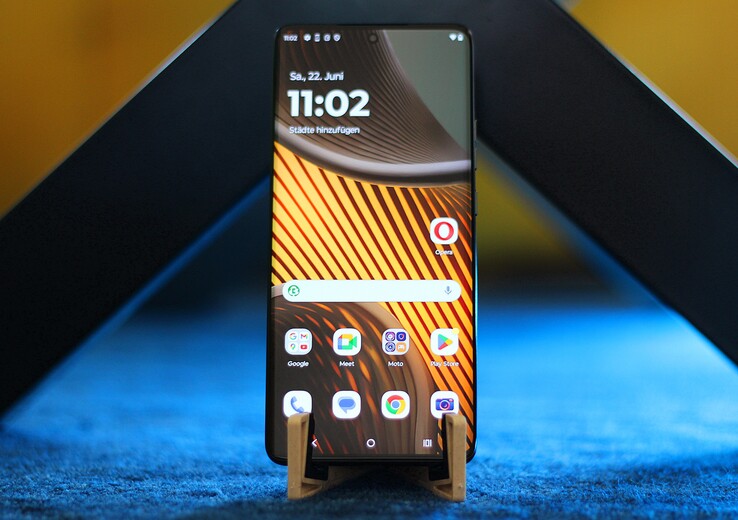
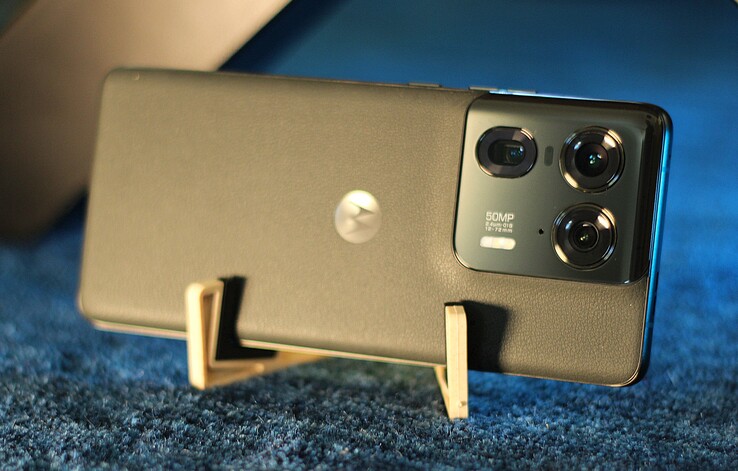










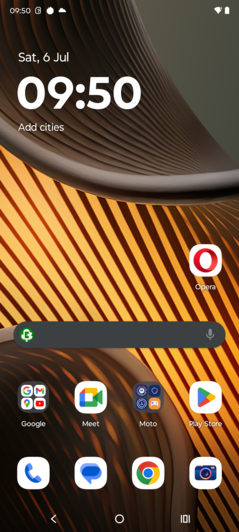
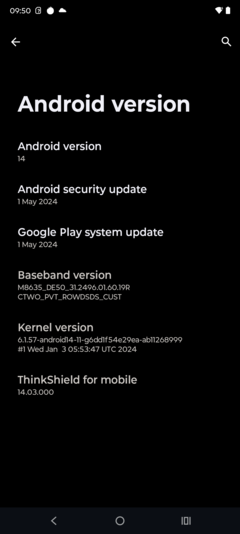
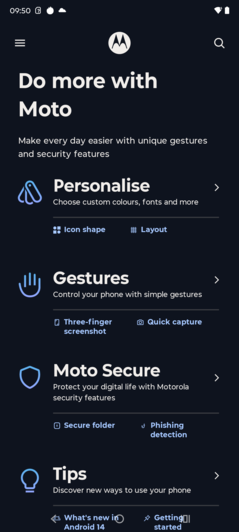
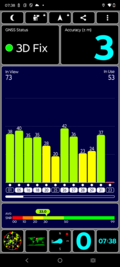
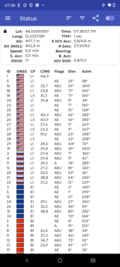



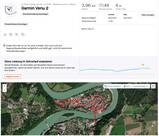
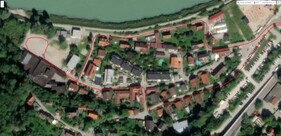
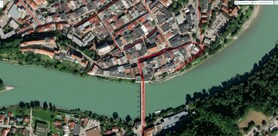


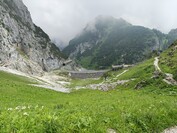






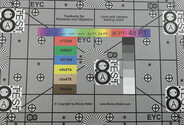
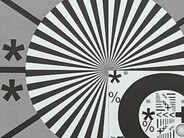
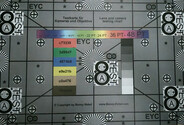
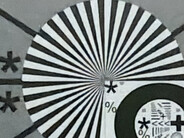
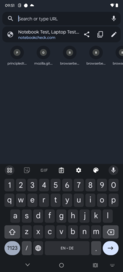
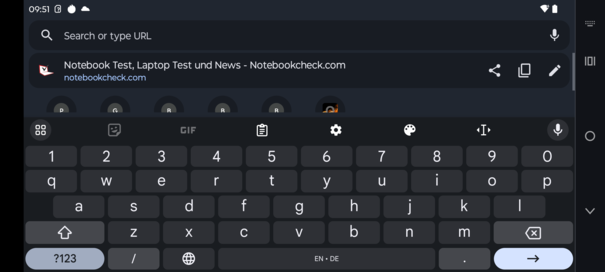
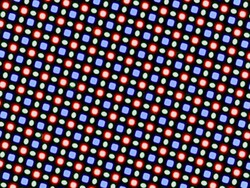
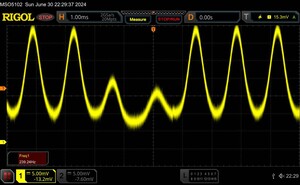





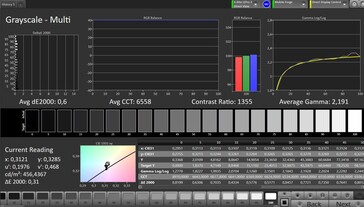
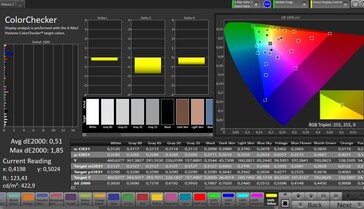
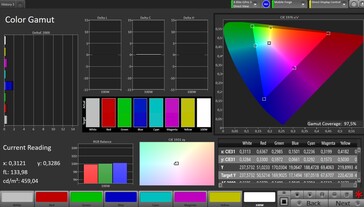
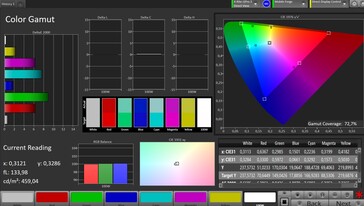
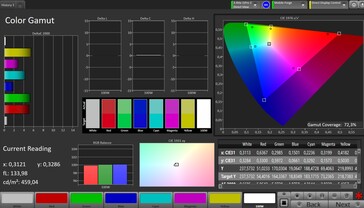
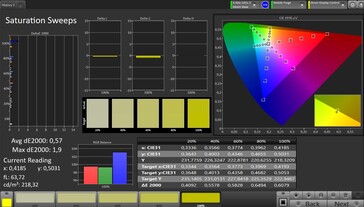
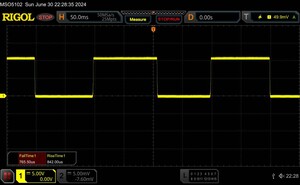
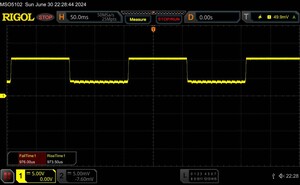
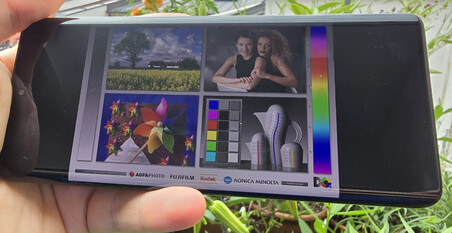

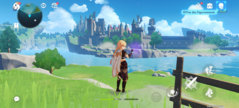

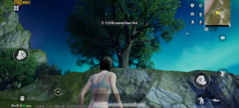
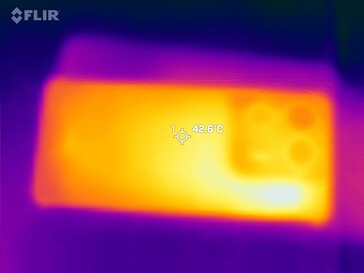
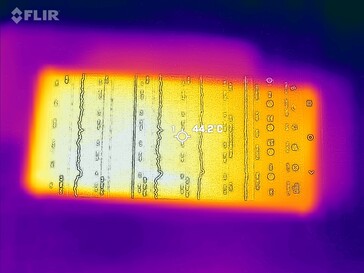
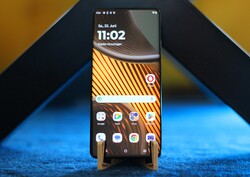
 Total Sustainability Score:
Total Sustainability Score: 
